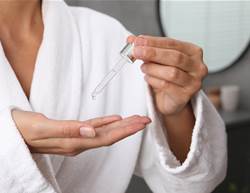The ice water facial is having a moment online, but the ritual predates social media. Beauty fans have long used cold water to wake up skin. A pop-culture reference many recall is the opening scene of Mommie Dearest, where Joan Crawford dunks her face in a bowl of ice and water—an early take on the now-viral trend.
Dermatologists say splashing the face with cold water can offer short-term cosmetic effects, not permanent change. The chill may briefly constrict surface blood vessels, which can make skin look brighter, pores appear smaller and puffiness seem reduced.
How to rinse face with cold water
Most people can use cold tap water. For an extra-cold option, fill a bowl with ice and water and let it sit until the ice softens, then splash. It’s a quick wake-up and may deliver those temporary tone-and-tighten effects.
- Splash the face and neck with cold water for 1–2 minutes.
- Gently pat dry with a clean towel.
- Follow with a lightweight moisturising milk or your usual morning hydrator.
Cold exposure isn’t for everyone. If you have sensitive skin, rosacea or broken capillaries, speak with a dermatologist before trying prolonged or extreme cold on the face.
Benefits of rinsing your face with cold water
Dermatologists say the glow-boosting effects are real, even if short-lived. “You’re not imagining the beneficial effects that come from temperature-triggered blood vessel constriction,” says board-certified dermatologist Dr Mona Gohara.
Cold exposure has long been used to settle inflammation and soreness in the body. Face rinsing works on a similar principle. “While there’s limited direct clinical research on cold water alone improving skin health, we can borrow what we know from basic physiology,” Dr Gohara says. “The cold constricts blood vessels, reducing inflammation and swelling. A cold splash causes vasoconstriction, which temporarily minimises redness and puffiness.” Effects are temporary, but noticeable for many.
It calms inflammation and redness
“This is similar to icing an injury—it constricts the blood vessels, which in turn helps to reduce inflammation,” says Dr Gohara. “For example, cooling the skin is great for rosacea. In fact, one of the tricks we tell patients to try when they’re flushing is to put a cool (but not ice cold) compress on the skin to bring down the temperature and the redness.”
It de-puffs the eye area
Cold helps deflate fluid build-up. “The puffiness decreases because that vasoconstriction limits fluid buildup around the eyes,” says Dr Gohara. A few cold splashes can work faster than tools like ice rollers for water balloon-like under-eye swelling.
It tightens the appearance of pores and brightens skin
“Cold water first constricts superficial vessels, then as your skin warms back up, they dilate, and that quick contrast boosts circulation and oxygen flow, which makes skin appear more radiant,” Dr Gohara says. Pores do not technically shrink, but they can look smaller because the skin surface tightens briefly.
Who should not do a cold water rinse
“Oily skin types will benefit more from washing, not just rinsing, their skin in the morning with a mild cleanser to remove residual sweat and excess oil,” says Dr Gohara. For mature or dry skin, a brief cold-water rinse without cleanser may help avoid stripping natural oils and support the skin barrier.
Is the ice water facial safe?
The viral ice-water facial involves dunking the face in a bowl of icy water, which dermatologists do not recommend. “An occasional ice water dip for a few seconds is fine, but moderation is key,” says Dr Gohara. “Submerging your face in ice water can create serious trauma to the skin. Extremes like freezing cold water are bad, and if it hurts, it’s not good for you.”
The bottom line
Cold water can deliver short-term benefits like reduced puffiness, less visible redness and a temporary tightening effect. Long-term skin changes are unlikely. If you try it, keep the water cool rather than freezing, limit exposure to brief splashes, and choose a gentle cleanse in the morning if your skin is oily.










